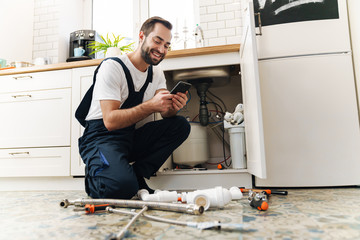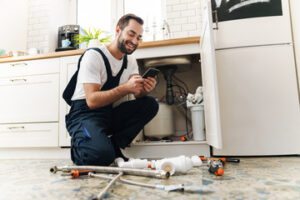Plumber Chatsworth use their hands and minds to install, repair, and maintain the water and sewage systems that supply fresh, clean drinking water and eliminate waste. They also work on gas lines and appliances, and interpret blueprints and plans to ensure plumbing construction complies with building codes and regulations.
Plumbing jobs offer good income, and the career is exciting because every day brings a different challenge. The job can be physically demanding, and the work is often hazardous.

Plumbers install and repair pipes, fixtures, and appliances that supply water, drain waste, and control sewage systems. Their responsibilities include interpreting blueprints and building codes to plan plumbing installations, laying pipe, connecting fixtures, and testing the system for leaks and proper functioning. Plumbers also work with customers to determine their needs and provide advice on plumbing solutions.
Residential plumbers typically focus on installing and repairing plumbing fixtures in homes and apartment buildings. This can include toilets, sinks, showers, and bathtubs. They may also work on larger-scale plumbing systems for hospitals, malls, and office buildings. Licensed residential plumbers are familiar with a wide range of household plumbing issues, including clogged drains, leaky faucets, and rusty water heaters.
Commercial plumbers are responsible for the vast majority of plumbing installation and maintenance in public buildings, such as schools, hospitals, and shopping centers. Their work is more complex than that of a residential plumber, as they deal with bigger systems and are often required to make more intricate repairs.
A career as a plumber can be physically demanding due to the nature of the job. Plumbers frequently bend over and crawl in tight spaces, and they are regularly exposed to dangerous chemicals and sewage. Due to the unpredictable nature of plumbing emergencies, plumbers must be available on call at all times and can expect to work evenings and weekends. This can lead to burnout and low morale, so it is important for prospective plumbers to carefully consider the trade before pursuing it. In addition, the physical demands of plumbing can make it a poor choice for people with certain health conditions or aversions to manual labor.
Installation of Plumbing Fixtures
In addition to repairing and replacing existing fixtures, plumbers install new plumbing fixtures in homes and businesses. This includes toilets, showerheads, faucets, sinks, and more. They also set up the drainage pipes, which carry waste water away from the fixtures. They may also install vent pipes to allow air into the drainage system. This helps prevent foul odors from arising in the home or business.
When installing new fixtures, plumbers follow the manufacturer’s instructions carefully. They make sure all connections are secure and tight, and they test the fixture to ensure it works properly. In addition, they use tools and supplies like pipe wrenches, screwdrivers, Teflon tape, and pipe cutters. They may also need to cut holes in the walls and floors to accommodate the new fixtures.
Plumbing fixtures are not just functional necessities, they can also add a touch of style to a room. They are available in a variety of finishes, styles, and configurations to complement any decor. Professional plumbers can offer advice on the best fixtures to suit a customer’s needs and budget.
When installed properly, new plumbing fixtures can reduce a homeowner’s utility bills and improve their comfort level. Old or worn-out fixtures are more prone to leaks, clogs, and other problems that can lead to expensive repairs and replacements. Upgrading to energy-efficient fixtures is a great way to reduce these costs while also helping the environment. In addition, new fixtures can increase a home’s resale value and appeal to potential buyers.
Maintenance and Repair of Plumbing Systems
A plumbing system is used daily to perform many vital functions, including providing water for drinking and cooking, flushing wastes out of homes and businesses, and heating systems. As a result, wear and tear is inevitable, and pipes and fixtures can break down over time. Plumbers repair and maintain these systems to ensure they continue to function properly. They may install new fixtures or replace old ones to improve functionality and aesthetics. They also diagnose problems with existing pipes and fixtures, such as leaks or clogs, and use specialized tools to clear blockages.
Plumbers often work in construction sites, where they may need to lay out piping according to blueprints or work with contractors and other tradespeople to install building components. This can include laying out sewage and drainage systems, connecting them to appliances, and testing the water for quality and safety. Plumbers may also need to inspect plumbing systems in older buildings to determine if they are up to code.
Leaky faucets, running toilets, and water heaters waste money and resources by causing unnecessary water loss. By performing regular maintenance and repairs, plumbers help homeowners and businesses reduce their energy costs and water consumption.
Some plumbing jobs require on-call or emergency services, so plumbers must be available to respond to calls at any time. This can lead to a variable schedule and frequent overtime. In addition, plumbers may need to work in inclement weather or on public holidays. Many plumbers are self-employed, which offers greater control over work schedules and the ability to accept more challenging projects. However, this career can be physically demanding and requires significant travel to different job sites. It is also subject to the economic fluctuations of the construction industry.
Installation and Maintenance of Gas Lines
One of the primary duties that plumbers do is the installation and maintenance of gas lines. Since natural gas is flammable, it’s vital that these lines are properly installed and maintained to avoid fire hazards and other problems. Plumbers install new gas lines by digging trenches or excavating existing ones and then laying the pipes according to a blueprint or plan. They also make sure that the joints are secure and that there are no leaks.
In addition, plumbers perform routine inspections of the gas lines in a home. They look for any rust or corrosion on the lines, which can result in leaks that can be dangerous for homeowners. Leaking gas lines can cause carbon monoxide poisoning, so it’s important that they are checked regularly by a professional.
Plumbers also repair leaking gas lines by using techniques like pipe lining. This involves cleaning the inside of a pipe, inserting a lining material, and then curing it in place. This method is less invasive than replacing the entire line and can be more cost-effective in some cases. However, it’s still important for homeowners to recognize signs that their gas lines need repairs or replacement, such as a change in gas usage or an odor that’s similar to rotten eggs (this is caused by an additive called mercaptan).
For those who want to learn more about becoming a plumber or would like to schedule service for damaged gas lines, contact us today at Petri Plumbing, Heating, Cooling & Drain Cleaning and we’ll send a qualified Brooklyn plumber to your home. It’s always best to leave these tasks to professionals who have the proper training and knowledge to handle them safely.
Interpretation of Building Codes and Regulations
A plumbing contractor must interpret local building codes and regulations, which dictate how a plumbing system is constructed. Building inspectors are responsible for enforcing these laws, which can result in penalties if violations are committed. Building inspectors may work for a county sheriff’s office, the building department of a city or a fire prevention bureau.
A plumber must also ensure that a plumbing system conforms with applicable sections of the National Plumbing Code (NPC). The NPC provides local governments, construction industry professionals and others with a common set of standards for designing and installing plumbing systems in buildings. These standards are based on the principle that plumbing systems should be safe, sanitary and economical to operate and maintain.
The NPC includes sections that govern the erection, installation, alteration, repair, replacement, relocation or use of plumbing systems, nonflammable medical and nonmedical gas, sewage and septic tanks and systems, water heaters and venting systems. It also covers piping in the basement of residential buildings and the installation, alteration or repair of appliances.
NPC regulations cover such issues as the sizing of water pipes, which is based on the number of occupants and the type of occupancy of the building. In addition, the code mandates that a backflow preventer be installed on all plumbing fixtures and piping that can potentially cause a backflow condition.
The NPC also requires that buried piping be protected from damage by means of a relieving arch, the use of a pipe sleeve or the construction of a pipe in the foundation wall at a point not less than two pipe sizes larger than the diameter of the buried piping. Buried piping must also be supported throughout its length.


 It’s A Truck
It’s A Truck


